torque CHEVROLET CAMARO 1967 1.G Chassis Owners Manual
[x] Cancel search | Manufacturer: CHEVROLET, Model Year: 1967, Model line: CAMARO, Model: CHEVROLET CAMARO 1967 1.GPages: 659, PDF Size: 114.24 MB
Page 378 of 659
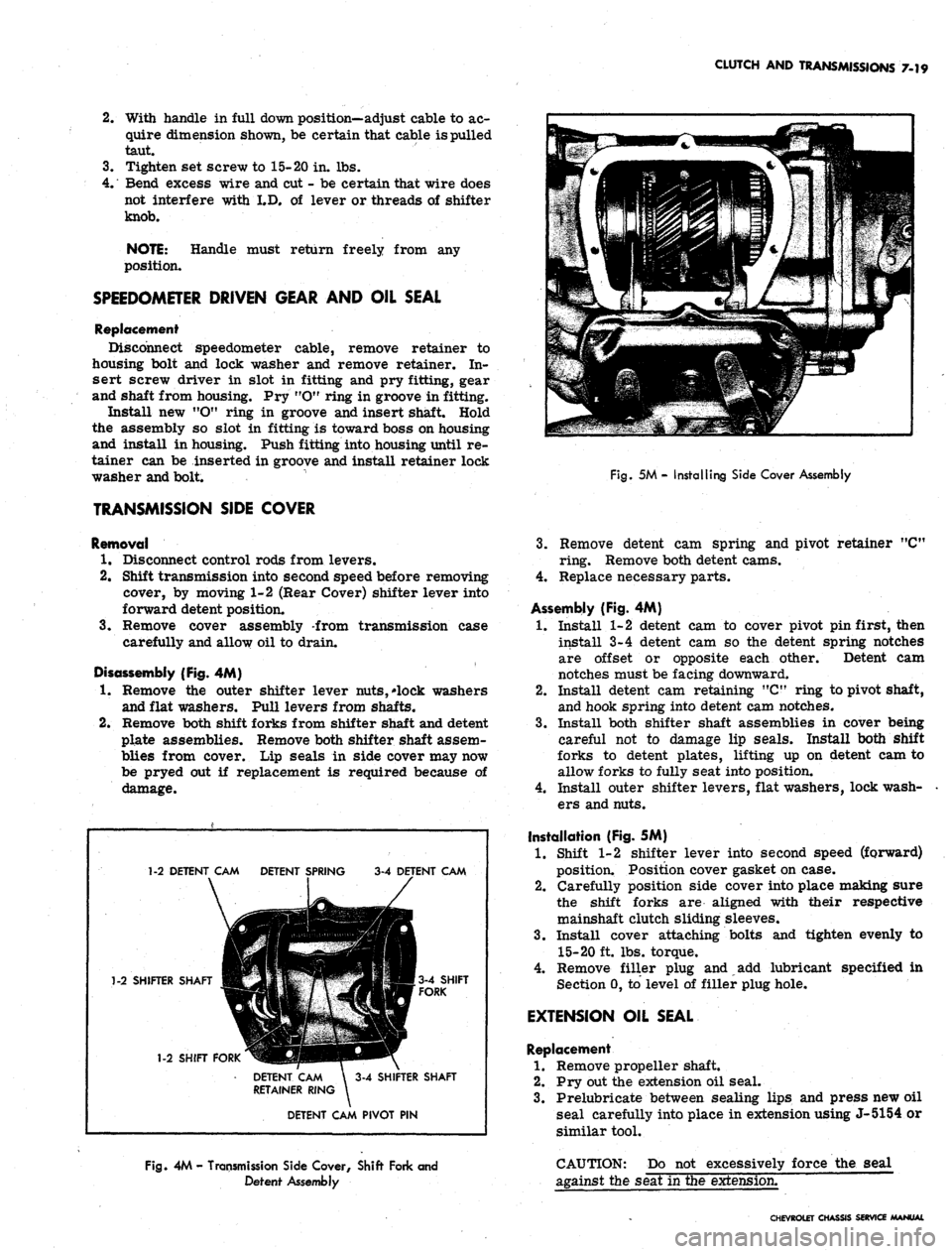
CLUTCH AND TRANSMISSIONS 7-19
2.
With handle in full down position—adjust cable to ac-
quire dimension shown, be certain that cable is pulled
taut.
3.
Tighten set screw to 15-20 in. lbs.
4.
Bend excess wire and cut - be certain that wire does
not interfere with I.D. of lever or threads of shifter
knob.
NOTE: Handle must return freely from any
position.
SPEEDOMETER DRIVEN GEAR AND OIL SEAL
Replacement
Disconnect speedometer cable, remove retainer to
housing bolt and lock washer and remove retainer. In-
sert screw driver in slot in fitting and pry fitting, gear
and shaft from housing. Pry "O" ring in groove in fitting.
Install new "O" ring in groove and insert shaft Hold
the assembly so slot in fitting is toward boss on housing
and install in housing. Push fitting into housing until re-
tainer can be inserted in groove and install retainer lock
washer and bolt.
Fig.
5M - Installing Side Cover Assembly
TRANSMISSION SIDE COVER
Removal
1.
Disconnect control rods from levers.
2.
Shift transmission into second speed before removing
cover, by moving 1-2 (Rear Cover) shifter lever into
forward detent position.
3.
Remove cover assembly -from transmission case
carefully and allow oil to drain.
Disassembly (Fig. 4M)
1.
Remove the outer shifter lever nuts,*lock washers
and flat washers. Pull levers from shafts.
2.
Remove both shift forks from shifter shaft and detent
plate assemblies. Remove both shifter shaft assem-
blies from cover. Lip seals in side cover may now
be pryed out if replacement is required because of
damage.
1-2 DETENT CAM DETENT SPRING
3-4 DETENT CAM
1-2 SHIFTER SHAFT
1-2 SHIFT FORK
3-4 SHIFT
FORK
DETENT CAM \ 3-4 SHIFTER SHAFT
RETAINER RING
DETENT CAM PIVOT PIN
3.
Remove detent cam spring and pivot retainer "C"
ring. Remove both detent cams.
4.
Replace necessary parts.
Assembly (Fig. 4M)
1.
Install 1-2 detent cam to cover pivot pin first, then
install 3-4 detent cam so the detent spring notches
are offset or opposite each other. Detent cam
notches must be facing downward.
2.
Install detent cam retaining "C" ring to pivot shaft,
and hook spring into detent cam notches.
3.
Install both shifter shaft assemblies in cover being
careful not to damage lip seals. Install both shift
forks to detent plates, lifting up on detent cam to
allow forks to fully seat into position.
4.
Install outer shifter levers, flat washers, lock wash-
ers and nuts.
Installation (Fig. 5M)
1.
Shift 1-2 shifter lever into second speed (forward)
position. Position cover gasket on case.
2.
Carefully position side cover into place making sure
the shift forks are aligned with their respective
mainshaft clutch sliding sleeves.
3.
Install cover attaching bolts and tighten evenly to
15-20 ft. lbs. torque.
4.
Remove filler plug and add lubricant specified in
Section 0, to level of filler plug hole.
EXTENSION OIL SEAL
Replacement
1.
Remove propeller shaft.
2.
Pry out the extension oil seal.
3.
Prelubricate between sealing lips and press new oil
seal carefully into place in extension using J-5154 or
similar tool.
Fig.
4M - Transmission Side Cover/ Shift Fork and
Detent Assembly
CAUTION: Do not excessively force the seal
against the seat in the extension.
CHEVROLET CHASSIS SERVICE MANUAL
Page 379 of 659

CLUTCH
AND
TRANSMISSIONS
7-20
COMPONENT PARTS REPLACEMENT
3.
4.
5.
6.
TRANSMISSION REPLACEMENT
(EXC.
CORVETTE)
Removal From Vehicle
1.
Remove shift lever trim plate and dust boot.
Remove shift lever assembly.
Raise vehicle
to
desired working height.
Disconnect
the
speedometer cable from speedometer
driven gear fitting.
.
~
. •
Remove propeller shaft, then support engine
at the
oil
pan
rail with
a
jack
or
other suitable support
capable
of
supporting
the
engine when transmission
is removed.
Disconnect shift lever bracket assembly from exten-
sion
and
remove
all 3
transmission shifter levers
from shifter shafts, (leave linkage connected
to
levers)
and
remove bracket assembly levers
and
linkage.
Remove extension mount7 to-crossmember attaching
bolts.
Loosen transmission crossmember
and
move rear-
ward
or
remove.
Remove
the
transmission-to-clutch housing retaining
bolts
and
install two guide pins, J-1126,
in
top holes.
Slide
the
transmission straight back until
the
input
shaft
is
free
of
splines
in the
clutch disc.
Slide
the
transmission rearward
to
allow sufficient
clearance
of
input shaft
and
clutch housing. Then tilt
input shaft
end of
transmission downward and with-
8.
9.
10.
11.
draw transmission from vehicle.
installation
to
Vehicle
1.
Raise transmission
and
rotate
as
necessary-to start
input shaft into clutch disc
and
slide transmission
forward until
it
bottoms against clutch housing.
Re-
move guide pins.
2.
Install
the
transmission-to-clutch housing retaining
bolts.
Torque
all
four retaining bolts
to 50 ft. lbs.
3.
Raise engine
and
position extension mount
to
cross-
member,
and
loosely install
the
retaining bolts.
Tighten crossmember
to
frame retaining bolts.
4.
Remove temporary support from engine, and torque
the extension mount retaining bolts.
5. Install propeller shaft.
6. Install control lever bracket assembly
to
transmis-
sion extension
and
connect shifter levers
to
shifter
shafts.
7. Fill transmission
to
level
of
filler plug hole with
correct lubricant specified
in
Section
0.
8. Lower vehicle and install shift lever assembly, check
shift pattern and adjust linkage
as
required.
9. Install trim plate and dust boot.
CORVETTE TRANSMISSION REPLACEMENT
Refer
to
similar procedure under 3-Speed Corvette
Transmission.
FOUR-SPEED (SAGINAW) TRANSMISSION
INDEX
Page
General Description
7-20
Maintenance
and
Adjustments
. . 7-21
Shift Linkage Adjustment.
. 7-21
Speedometer Driven Gear
and
Oil Seal ................
(See
Muncie 4-Speed)
Side Cover
7-22
Page
Removal
. . , 7-22
Disassembly
. . 7-22
Assembly
. . . 7-22
Installation
. 7-22
Extension
Oil
Seal
(See
Muncie 4-Speed)
Transmission Replacement (See Muncie 4-Speed)
GENERAL DESCRIPTION
The Saginaw four speed fully synchronized
(all
forward
gears) transmission incorporates helical drive gears
throughout.
The main drive gear
is
supported
by a
ball bearing
at
the front
end of the
transmission case and
is
piloted
at its
front
end in an oil
impregnated bushing mounted
in the
engine crankshaft.
The
front
end of the
mainshaft
is
piloted
in a row of
roller bearings
set
into
the
hollow
end
of
the
main drive gear
and the
rear end
is
carried
by a
ball bearing mounted
in the
front
of the
extension housing.
The countergear
is
carried
on a
single
row of
rollers
at both ends while thrust
is
taken on thrust washers
lo-
cated between
the
ends
of the
gear and
the
thrust bosses
in
the
case. Ah anti-rattle plate assembly
at the
front
of
the countergear provides
a
constant spring tension
be-
tween
the
counter
and
clutch gears
to
reduce torsional
vibrations.
The
sliding reverse idler gear
is
carried
on
a bushing finish bored
in
place.
It
rotates
on a
short
idler shaft retained by
a
woodruff
key.
The synchronizer assemblies consist
of a
clutch
hub,
clutch sleeve,
two
clutch
key
springs and three energizer
clutch keys
and are
retained
as an
assembly on
the
main
shaft
by a
snap ring.
A great deal
of
similarity
and
interchangeability
now
exists between
the new 3 and
4-speed Saginaw trans-
missions.
However,
the
synchronizer assembly
at the
front
of the
mainshaft
is
used
for the
third and fourth rather than
the
second
and
third shift.
The
synchronizer assembly
at
the rear
of the
mainshaft
is
used
for the
first and second
rather than
the
first
and
reverse shift. Gear teeth
cut
in
the
first and second synchronizer sleeve (reverse gear)
distinguish
it
from
the
third
and
fourth synchronizer
sleeve.
Starting from
the
front, gears
on the
mainshaft
are
third, second
and
first rather than second, first and
re-
verse.
A
fourth blocker ring
is
used between
the 1-2
synchronizer assembly
and
first gear
on the
four-speed
transmissions.
The cover
on the new
four-speed transmission
is lo-*
cated
on the
left-hand side
of the
case.
It is
similar
to
the three-speed cover with
the
addition
of a
reverse
shifter shaft assembly, detent ball
and
detent spring.
Disassembly
and
assembly procedures
are
covered
in
this section.
CHEVROLET CHASSIS SERVICE MANUAL
Page 380 of 659

CLUTCH AND TRANSMISSIONS 7-21
MAINTENANCE AND ADJUSTMENTS
SHIFT LINKAGE ADJUSTMENT
(CHEVROLET & CHEVELLE)
1.
Set Lever (L) (M) and (P) in neutral detent position.
2.
Move Lever Stud (A) to neutral detent position and
insert Locating Gauge (B) into Control Lever Bracket
Assembly.
3.
Install Reverse Rod (H) with retainer on Lever (T).
4.
Maintaining Lever (T) against Locating Gauge, Adjust
Clevis (R) at Lever (P) until Clevis Pin freely passes
through holes in Clevis (R) and Lever (P).
5.
Install Clevis Pin, Washer and Cotter Pin; tighten
Nut (S) against Clevis (R).
6. Install Rod (K) with retainer on Lever (C).
7.
Maintaining Lever (C) against Locating Gauge, adjust
Clevis (N) at Lever (M) until Clevis Pin freely
passes through holes in Clevis (N) and Lever (M).
8. Install Clevis Pin, Washer and Cotter Pin; tighten
Nut (O) against Clevis (N).
9. Install Rod (J) with retainer on Lever (L).
10.
With two Jam Nuts (G), (E) and Swivel (F) loose on
Rod (J) insert and attach Swivel (F) with retainer to
Lever (D).
11.
Maintaining Lever (D) against Locating Gauge (B)
while holding Swivel (F) run Jam Nut (G) against
Swivel (F) then tighten other Jam Nut (E) against
swivel.
12.
Remove Locating Gauge and check shifts to insure
proper operation, readjust if necessary.
SHIFT LINKAGE ADJUSTMENT (CHEVY II)
1.
Set Levers (H) (R) and (T) in neutral detent position.
2.
Move Lower Control Lever (A) to neutral detent po-
sition and insert Locating Gauge (B) into Control
Lever Bracket Assembly.
3.
Install Reverse Control Rod (G) with retainer on
Lever (X).
4.
Maintaining Lever (X) in neutral position with Locat-
ing Gauge (B), Adjust Clevis (V) at lever (T) until
Clevis Pin freely passes through hole in Clevis (V)
and Lever (T).
5.
Install Clevis Pin, Washer and Cotter Pin. Tighten
Jam Nut (W) to specified torque against Clevis.
6. Install Control Rod (F) with retainer on Lever (C).
7.
Maintaining Lever (C) in neutral position with Locat-
ing Gauge (B), Jam Nuts (M and S) and Swivel (N)
loose on Rod (F), attach to Lever (R) with retainer.
8. While holding Swivel (N) run Jam Nut (M) against
Swivel (N) and tighten Jam Nut (S) against Swivel (N).
9. Install Rod (E) with retainer on Lever (D).
10.
Maintaining Lever (D) in neutral position with Locat-
ing Gauge (B) and Jam Nut (J and L) and Swivel (K)
loose on Rod (E) attach to Lever (H) with retainer.
11.
While holding Swivel (K) run Jam Nut (J) against
Swivel (K) and tighten Jam Nut (L) against Swivel (K).
12.
Remove Locating Gauge (B) and shift to insure proper
operation. Readjust clevis and swivels if necessary.
SHIFT LINKAGE ADJUSTMENT
(CAMARO AND CORVETTE)
1.
Set Transmission Shift Levers in neutral position.
2.
Move Lever Arm (A) and Lever (C) (D) and (E) to
neutral position and insert Locating Gauge (B) into
Control Lever Bracket Assembly.
N
f E
Fig.
IX - Shift. Linkage (Chevrolet & Chevelle)
CHEVROLET CHASSIS SERVICE MANUAL
Page 381 of 659

CLUTCH AND TRANSMISSIONS 7-22
Fig.
2X - Shift Linkage (Chevy II)
3.
Install Reverse Rod (J) with Retainer on Lever (N).
4.
With two Jam Nuts and Swivel loose on Rod (J) insert
and attach Swivel with Retainer to Lever (E).
5. Maintaining Lever (E) against Locating Gauge (B)
while holding Swivel run front Jam Nut against Swivel
then tighten rear Jam Nut against Swivel to specified
torque.
6. Install Rod (O) with Retainer on Lever (M)o
7. With two Jam Nuts and Swivel loose on Rod (O) insert
and attach Swivel with Retainer to Lever (C).
8. Repeat Step 5 Maintaining Lever (C) against Locating
Gauge (B).
9. Install Rod (K) with Retainer on Lever (L).
10.
With two Jam Nuts and Swivel retain to Lever (D).
11.
Repeat Step 5 maintaining Lever (D) against Locating
Gauge (B).
12.
Remove Locating Gauge and check shift to insure
proper operation. Readjust if necessary.
N
<
^ ii
K
3 A
1-2 DETENT
CAM
PIVOT PIN
DETENT
SPRING
3-4 DETENT
CAM
3-4
SHIFT FORK
1-2 SHIFTER
SHAFT ASSY.
REVERSE
SHIFTER SHAFT
ASSY.
3-4 SHIFTER
SHAFT ASSY.
DETENT SPRING
RETAINER
& BALL (UNDERNEATH) 1-2 SHIFTER R,NG
FORK
Fig.
3X - Comoro and Corvette Shift Linkage
Fig.
4X - Transmission Side Cover/ Shift Fork and Detent Assembly
TRANSMISSION SIDE COVER
Removal
1.
Disconnect control rods from levers.
2.
Shift transmission into neutral detent positions be-
fore removing cover.
3.
Remove cover assembly from transmission case
carefully and allow to drain.
Disassembly (Fig. 4X)
1.
Remove the outer shifter levers.
2.
Remove both shift forks from shifter shaft assem-
blies.
Remove all three shifter shaft assemblies
from cover. "O" ring seals around shifter shaft
may now be pryed out if required because of damage.
Remove reverse shifter shaft detent ball and spring,
3.
Remove detent cam spring and pivot retainer "C"
ring. Mark to identify for reassembly, then remove
both detent cams.
4.
Replace damaged parts.
CHEVROLET CHASSIS SERVICE MANUAL
Page 382 of 659
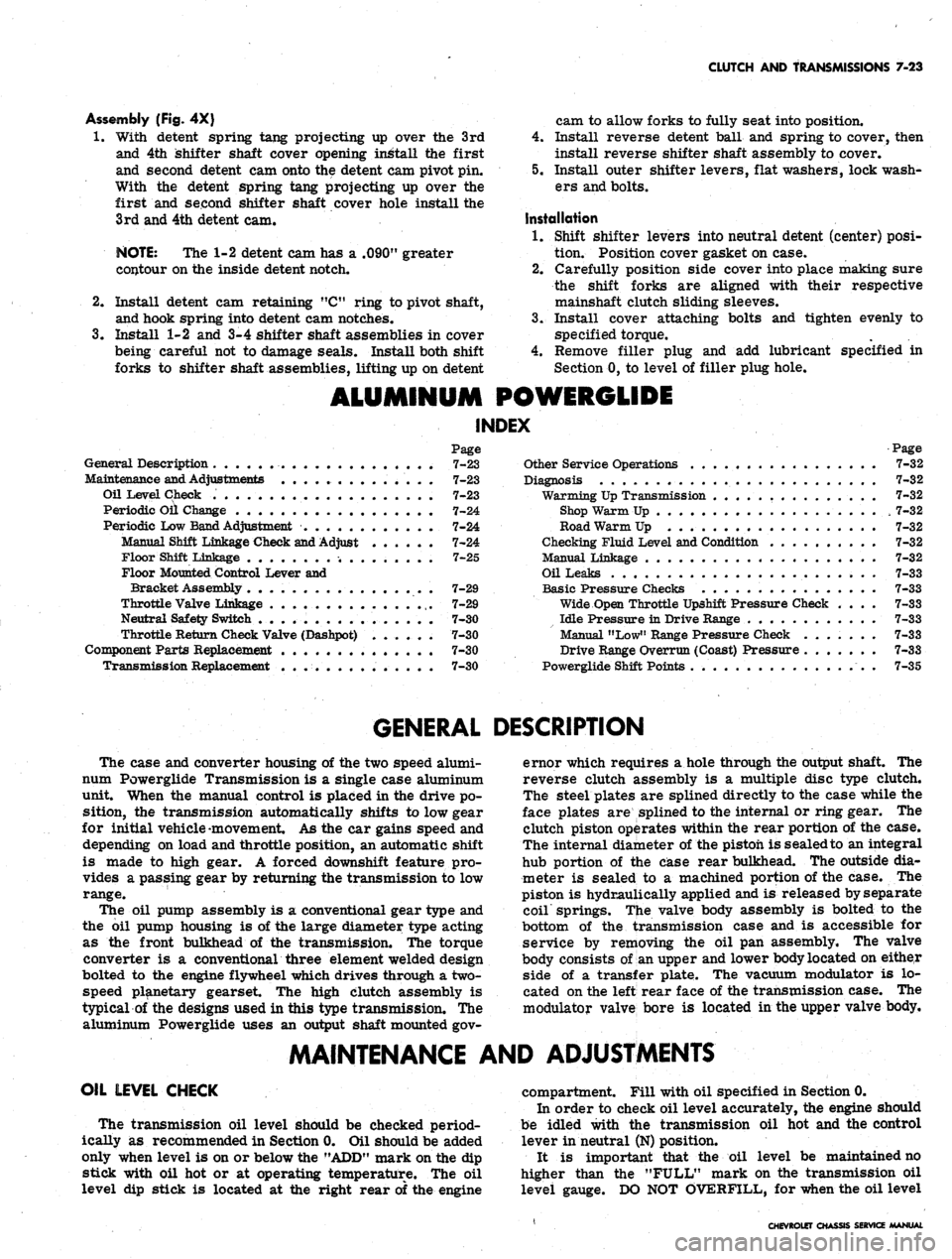
CLUTCH
AND
TRANSMISSIONS
7-23
Assembly (Fig.
4X)
1.
With detent spring tang projecting
up
over
the 3rd
and
4th
shifter shaft cover opening install
the
first
and second detent
cam
onto
the
detent
cam
pivot
pin.
With
the
detent spring tang projecting
up
over
the
first
and
second shifter shaft cover hole install
the
3rd
and 4th
detent
cam,
NOTE:
The 1-2
detent
cam has a
.090" greater
contour
on the
inside detent notch.
2.
3.
Install detent
cam
retaining
"C"
ring
to
pivot shaft,
and hook spring into detent
cam
notches.
Install
1-2 and 3-4
shifter shaft assemblies
in
cover
being careful
not to
damage seals. Install both shift
forks
to
shifter shaft assemblies, lifting
up on
detent
cam
to
allow forks
to
fully seat into position.
4.
Install reverse detent ball
and
spring
to
cover, then
install reverse shifter shaft assembly
to
cover.
5.
Install outer shifter levers, flat washers, lock wash-
ers
and
bolts.
Installation
1.
Shift shifter levers into neutral detent (center) posi-
tion. Position cover gasket
on
case.
2.
Carefully position side cover into place making sure
the shift forks
are
aligned with their respective
mainshaft clutch sliding sleeves.
Install cover attaching bolts
and
tighten evenly
to
specified torque.
Remove filler plug
and add
lubricant specified
in
Section
0, to
level
of
filler plug hole.
3.
4.
ALUMINUM POWERGLIDE
INDEX
Page
General
Description
7-23
Maintenance
and
Adjustments .............. 7—23
Oil
Level Check
7-23
Periodic
Oil
Change
7-24
Periodic
Low
Band Adjustment
7-24
Manual
Shift Linkage Check
and
Adjust
7-24
Floor
Shift Linkage
7-25
Floor
Mounted Control Lever
and
Bracket
Assembly
7-29
Throttle
Valve Linkage
.... 7-29
Neutral
Safety Switch
.. . 7-30
Throttle
Return Check Valve (Dashpot)
7-30
Component
Parts Replacement
7-30
Transmission
Replacement .............. 7—30
Page
Other
Service Operations
7-32
Diagnosis
7-32
Warming
Up
Transmission
7-32
Shop
Warm
Up , 7-32
Road
Warm
Up 7-32
Checking
Fluid Level
and
Condition
7-32
Manual
Linkage
7-32
Oil
Leaks
7-33
Basic
Pressure Checks
7-33
Wide
Open Throttle Upshift Pressure Check
.... 7-33
Idle
Pressure
in
Drive Range
7-33
Manual
"Low"
Range Pressure Check .......
7-33
Drive
Range Overrun (Coast) Pressure
.
.......
7-33
Powerglide
Shift Points
. . 7-35
GENERAL DESCRIPTION
The case
and
converter housing
of the two
speed alumi-
num Powerglide Transmission
is a
single case aluminum
unit. When
the
manual control
is
placed
in the
drive
po-
sition,
the
transmission automatically shifts
to low
gear
for initial vehicle movement.
As the car
gains speed
and
depending
on
load
and
throttle position,
an
automatic shift
is made
to
high gear.
A
forced downshift feature
pro-
vides
a
passing gear
by
returning
the
transmission
to low
range.
The
oil
pump assembly
is a
conventional gear type
and
the
oil
pump housing
is of the
large diameter type acting
as
the
front bulkhead
of the
transmission.
The
torque
converter
is a
conventional three element welded design
bolted
to the
engine flywheel which drives through
a
two-
speed planetary gearset.
The
high clutch assembly
is
typical
of the
designs used
in
this type transmission.
The
aluminum Powerglide uses
an
output shaft mounted
gov-
ernor which requires
a
hole through
the
output shaft.
The
reverse clutch assembly
is a
multiple disc type clutch.
The steel plates
are
splined directly
to the
case while
the
face plates
are
splined
to the
internal
or
ring gear.
The
clutch piston operates within
the
rear portion
of the
case.
The internal diameter
of the
pistoh
is
sealed to
an
integral
hub portion
of the
case rear bulkhead.
The
outside
dia-
meter
is
sealed
to a
machined portion
of the
case.
The
piston
is
hydraulically applied
and is
released
by
separate
coil springs.
The
valve body assembly
is
bolted
to the
bottom
of the
transmission case
and is
accessible
for
service
by
removing
the oil pan
assembly.
The
valve
body consists
of an
upper
and
lower body located
on
either
side
of a
transfer plate.
The
vacuum modulator
is lo-
cated
on the
left rear face
of the
transmission case.
The
modulator valve bore
is
located
in the
upper valve body.
MAINTENANCE
AND
ADJUSTMENTS
OIL LEVEL CHECK
The transmission
oil
level should
be
checked period-
ically
as
recommended
in
Section
0. Oil
should
be
added
only when level
is on or
below
the
"ADD" mark
on the dip
stick with
oil hot or at
operating temperature.
The oil
level
dip
stick
is
located
at the
right rear
of the
engine
compartment. Fill with
oil
specified
in
Section
0.
In order
to
check
oil
level accurately,
the
engine should
be idled with
the
transmission
oil hot and the
control
lever
in
neutral (N) position.
It
is
important that
the oil
level
be
maintained
no
higher than
the
"FULL" mark
on the
transmission
oil
level gauge.
DO NOT
OVERFILL,
for
when
the oil
level
CHEVROLET CHASSIS SERVICE MANUAL
Page 383 of 659
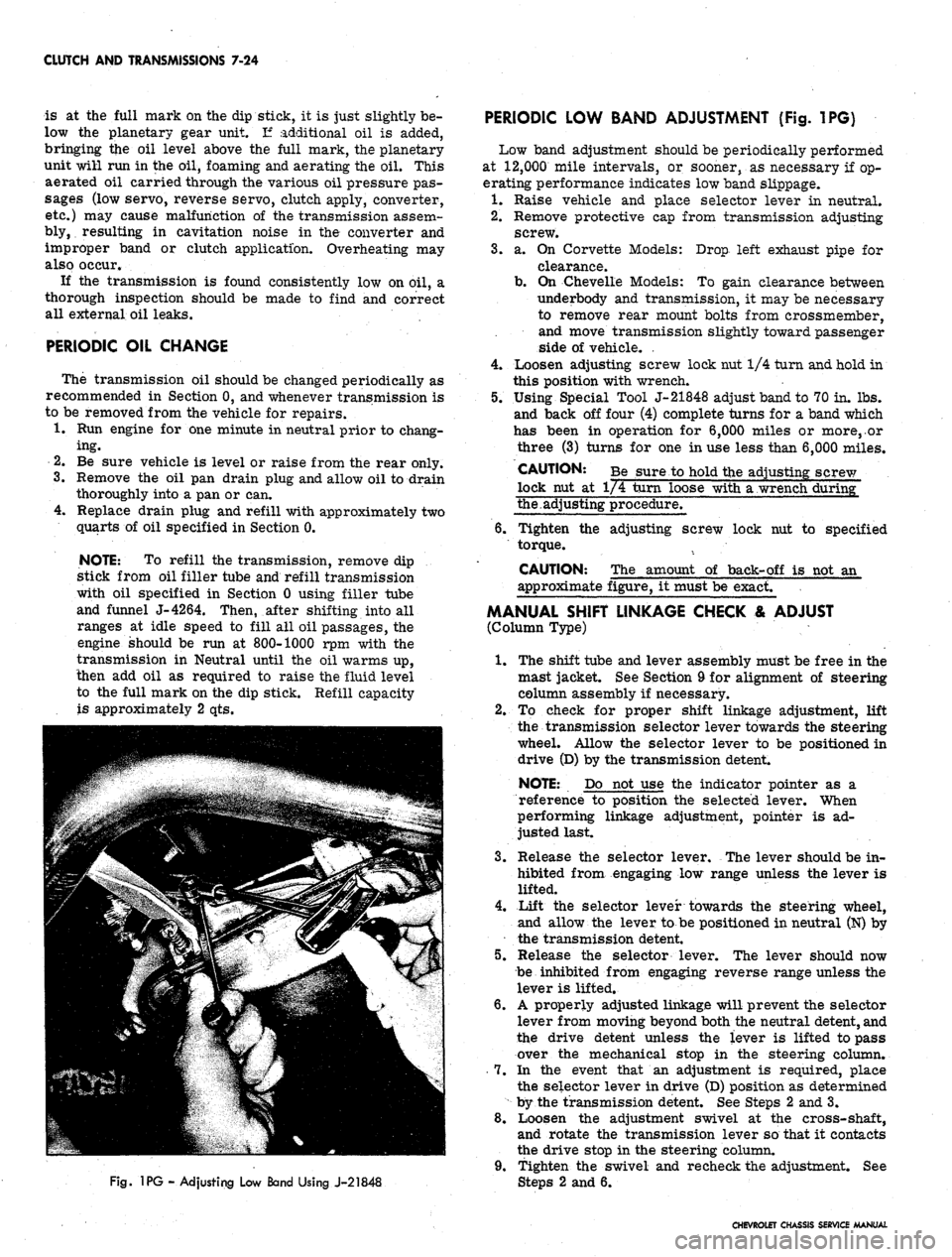
CLUTCH AND TRANSMISSIONS 7-24
is at the full mark on the dip stick, it is just slightly be-
low the planetary gear unit. If additional oil is added,
bringing the oil level above the full mark, the planetary
unit will run in the oil, foaming and aerating the oil. This
aerated oil carried through the various oil pressure pas-
sages (low servo, reverse servo, clutch apply, converter,
etc.) may cause malfunction of the transmission assem-
bly, resulting in cavitation noise in the converter and
improper band or clutch application. Overheating may
also occur.
If the transmission is found consistently low on oil, a
thorough inspection should be made to find and correct
all external oil leaks.
PERIODIC OIL CHANGE
The transmission oil should be changed periodically as
recommended in Section 0, and whenever transmission is
to be removed from the vehicle for repairs.
1.
Run engine for one minute in neutral prior to chang-
ing.
2.
Be sure vehicle is level or raise from the rear only.
3.
Remove the oil pan drain plug and allow oil to drain
thoroughly into a pan or can.
Replace drain plug and refill with approximately two
quarts of oil specified in Section 0.
NOTE: To refill the transmission, remove dip
stick from oil filler tube and refill transmission
with oil specified in Section 0 using filler tube
and funnel J-4264. Then, after shifting into all
ranges at idle speed to fill all oil passages, the
engine should be run at 800-1000 rpm with the
transmission in Neutral until the oil warms up,
then add oil as required to raise the fluid level
to the full mark on the dip stick. Refill capacity
is approximately 2 qts.
4.
Fig.
1PG - Adjusting Low Band Using J-21848
PERIODIC LOW BAND ADJUSTMENT (Fig. 1PG)
Low band adjustment should be periodically performed
at 12,000 mile intervals, or sooner, as necessary if op-
erating performance indicates low band slippage.
1.
Raise vehicle and place selector lever in neutral.
2.
Remove protective cap from transmission adjusting
screw.
3.
a. On Corvette Models: Drop left exhaust pipe for
clearance.
b.
On Chevelle Models: To gain clearance between
underbody and transmission, it may be necessary
to remove rear mount bolts from crossmember,
and move transmission slightly toward passenger
side of vehicle. .
4.
Loosen adjusting screw lock nut 1/4 turn and hold in
this position with wrench.
5.
Using Special Tool J-21848 adjust band to 70 in. lbs.
and back off four (4) complete turns for a band which
has been in operation for 6,000 miles or more,.or
three (3) turns for one in use less than 6,000 miles.
CAUTION: Be sure to hold the adjusting screw
lock nut at 1/4 turn loose with a wrench during"
the.adjusting procedure.
6. Tighten the adjusting screw lock nut to specified
torque.
CAUTION: The amount of back-off is not an
approximate figure, it must be exact.
MANUAL SHIFT LINKAGE CHECK & ADJUST
(Column Type)
1.
The shift tube and lever assembly must be free in the
mast jacket. See Section 9 for alignment of steering
column assembly if necessary.
2.
To check for proper shift linkage adjustment, lift
the transmission selector lever towards the steering
wheel. Allow the selector lever to be positioned in
drive (D) by the transmission detent.
NOTE: Do not use the indicator pointer as a
reference to position the selected lever. When
performing linkage adjustment, pointer is ad-
justed last.
3.
Release the selector lever. The lever should be in-
hibited from engaging low range unless the lever is
lifted.
4.
Lift the selector lever towards the steering wheel,
and allow the lever to be positioned in neutral (N) by
the transmission detent.
5.
Release the selector lever. The lever should now
be inhibited from engaging reverse range unless the
lever is lifted.
6. A properly adjusted linkage will prevent the selector
lever from moving beyond both the neutral detent, and
the drive detent unless the lever is lifted to pass
over the mechanical stop in the steering column.
7.
In the event that an adjustment is required, place
the selector lever in drive (D) position as determined
by the transmission detent. See Steps 2 and 3.
8. Loosen the adjustment swivel at the cross-shaft,
and rotate the transmission lever so that it contacts
the drive stop in the steering column.
9. Tighten the swivel and recheck the adjustment. See
2 and 6.
CHEVROLET CHASSIS SERVICE MANUAL
Page 390 of 659
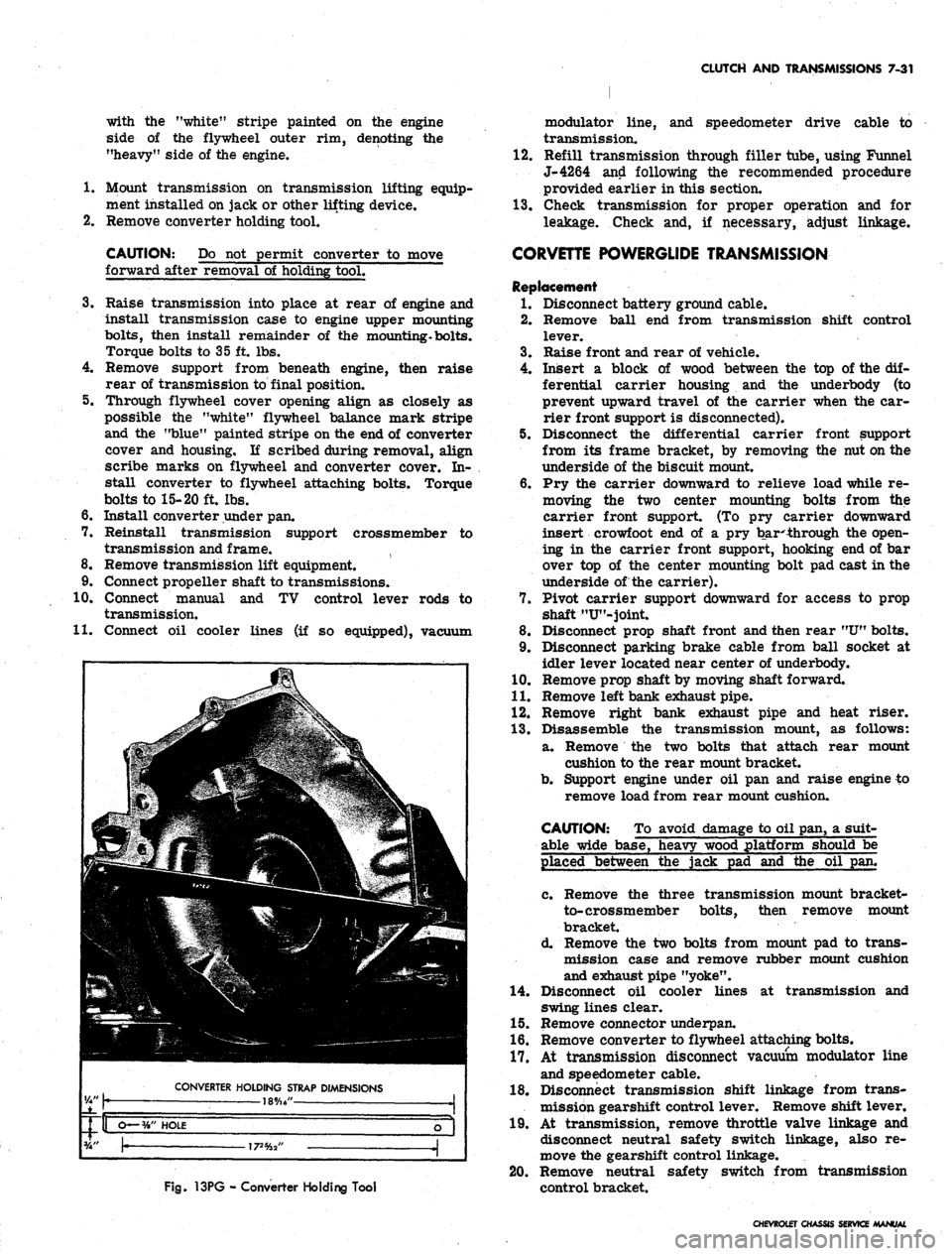
CLUTCH AND TRANSMISSIONS 7-31
with the "white" stripe painted on the engine
side of the flywheel outer rim, denoting the
"heavy" side of the engine.
1.
Mount transmission on transmission lifting equip-
ment installed on jack or other lifting device.
2.
Remove converter holding tool.
CAUTION: Do not permit converter to move
forward after removal of holding tool.
3.
Raise transmission into place at rear of engine and
install transmission case to engine upper mounting
bolts,
then install remainder of the mounting*bolts.
Torque bolts to 35 ft. lbs.
4.
Remove support from beneath engine, then raise
rear of transmission to final position.
5. Through flywheel cover opening align as closely as
possible the "white" flywheel balance mark stripe
and the "blue" painted stripe on the end of converter
cover and housing. If scribed during removal, align
scribe marks on flywheel and converter cover. In-
stall converter to flywheel attaching bolts. Torque
bolts to 15-20 ft. lbs.
6. Install converter under pan.
7. Reinstall transmission support crossmember to
transmission and frame.
8. Remove transmission lift equipment.
9. Connect propeller shaft to transmissions.
10.
Connect manual and TV control lever rods to
transmission.
11.
Connect oil cooler lines (if so equipped), vacuum
Fig.
13PG - Converter Holding Tool
modulato:* line, and speedometer drive cable to
transmission.
12.
Refill transmission through filler tube, using Funnel
J-4264 and following the recommended procedure
provided earlier in this section.
13.
Check transmission for proper operation and for
leakage. Check and, if necessary, adjust linkage.
CORVETTE POWERGLIDE TRANSMISSION
Replacement
1.
Disconnect battery ground cable.
2.
Remove ball end from transmission shift control
lever.
3.
Raise front and rear of vehicle.
4.
Insert a block of wood between the top of the dif-
ferential carrier housing and the underbody (to
prevent upward travel of the carrier when the car-
rier front support is disconnected).
5. Disconnect the differential carrier front support
from its frame bracket, by removing the nut on the
underside of the biscuit mount.
6. Pry the carrier downward to relieve load while re-
moving the two center mounting bolts from the
carrier front support. (To pry carrier downward
insert crowfoot end of a pry bar**hrough the open-
ing in the carrier front support, hooking end of bar
over top of the center mounting bolt pad cast in the
underside of the carrier).
7. Pivot carrier support downward for access to prop
shaft "U"-joint.
8. Disconnect prop shaft front and then rear
"U"
bolts.
9. Disconnect parking brake cable from ball socket at
idler lever located near center of underbody.
10.
Remove prop shaft by moving shaft forward.
11.
Remove left bank exhaust pipe.
12.
Remove right bank exhaust pipe and heat riser.
13.
Disassemble the transmission mount, as follows:
a. Remove the two bolts that attach rear mount
cushion to the rear mount bracket.
b.
Support engine under oil pan and raise engine to
remove load from rear mount cushion.
CAUTION: To avoid damage to oil pan, a suit-
able wide base, heavy wood platform should be
placed between the jack pad and the oil pan.
c. Remove the three transmission mount bracket-
to-crossmember bolts, then remove mount
bracket.
d. Remove the two bolts from mount pad to trans-
mission case and remove rubber mount cushion
and exhaust pipe "yoke".
14.
Disconnect oil cooler lines at transmission and
swing lines clear.
15.
Remove connector underpan.
16.
Remove converter to flywheel attaching bolts.
17.
At transmission disconnect vacuum modulator line
and speedometer cable.
18.
Disconnect transmission shift linkage from trans-
mission gearshift control lever. Remove shift lever.
19.
At transmission, remove throttle valve linkage and
disconnect neutral safety switch linkage, also re-
move the gearshift control linkage.
20.
Remove neutral safety switch from transmission
control bracket.
CHEVROLET CHASSIS SERVICE
Page 391 of 659
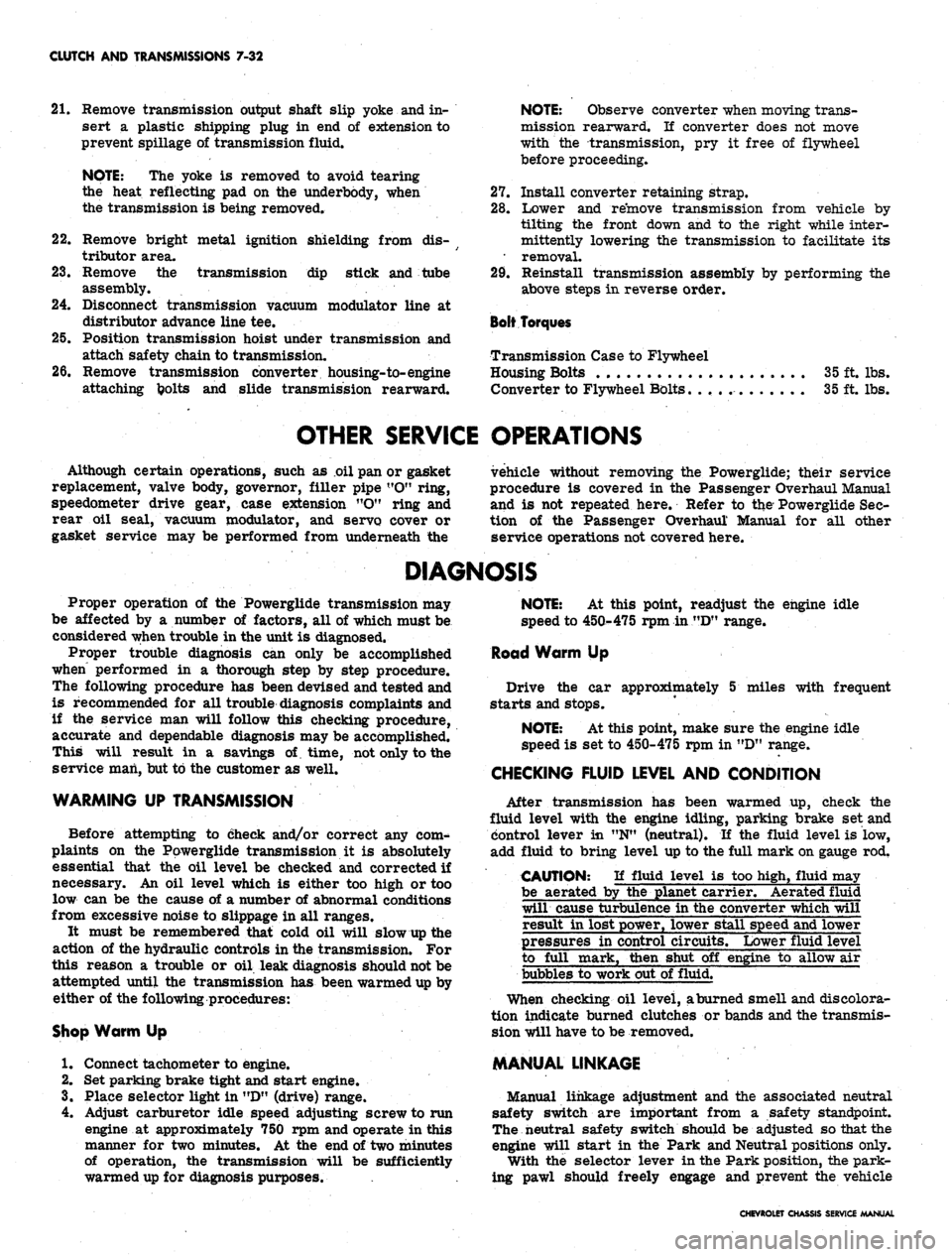
CLUTCH AND TRANSMISSIONS 7-32
21.
Remove transmission output shaft slip yoke and in-
sert a plastic shipping plug in end of extension to
prevent spillage of transmission fluid.
NOTE:
The yoke is removed to avoid tearing
the heat reflecting pad on the underbbdy, when
the transmission is being removed.
22.
Remove bright metal ignition shielding from dis-
tributor area.
23.
Remove the transmission dip stick and tube
assembly.
24.
Disconnect transmission vacuum modulator line at
distributor advance line tee.
25.
Position transmission hoist under transmission and
attach safety chain to transmission.
26.
Remove transmission converter housing-to-engine
attaching foolts and slide transmission rearward.
NOTE:
Observe converter when moving trans-
mission rearward. If converter does not move
with the transmission, pry it free of flywheel
before proceeding.
27.
Install converter retaining strap.
28.
Lower and remove transmission from vehicle by
tilting the front down and to the right while inter-
mittently lowering the transmission to facilitate its
• removal.
29.
Reinstall transmission assembly by performing the
above steps in reverse order.
Bolt Torques
Transmission Case to Flywheel
Housing Bolts 35 ft. lbs.
Converter to Flywheel Bolts. . , . . 35 ft. lbs.
OTHER SERVICE OPERATIONS
Although certain operations, such as oil pan or gasket
replacement, valve body, governor, filler pipe "O" ring,
speedometer drive gear, case extension "0" ring and
rear oil seal, vacuum modulator, and servo cover or
gasket service may be performed from underneath the
vehicle without removing the Powerglide; their service
procedure is covered in the Passenger Overhaul Manual
and is not repeated here. Refer to the- Powerglide Sec-
tion of the Passenger Overhaul Manual for all other
service operations not covered here.
DIAGNOSIS
Proper operation of the Powerglide transmission may
be affected by a number of factors, all of which must be
considered when trouble in the unit is diagnosed.
Proper trouble diagnosis can only be accomplished
when performed in a thorough step by step procedure.
The following procedure has been devised and tested and
is recommended for all trouble diagnosis complaints and
if the service man will follow this checking procedure,
accurate and dependable diagnosis may be accomplished.
This will result in a savings of time, not only to the
service man, but to the customer as well.
WARMING UP TRANSMISSION
Before attempting to check and/or correct any com-
plaints on the Powerglide transmission it is absolutely
essential that the oil level be checked and corrected if
necessary. An oil level which is either too high or too
low can be the cause of a number of abnormal conditions
from excessive noise to slippage in all ranges.
It must be remembered that cold oil will slow up the
action of the hydraulic controls in the transmission. For
this reason a trouble or oil leak diagnosis should not be
attempted until the transmission has been warmed up by
either of the following procedures:
Shop Warm Up
1.
Connect tachometer to engine.
2.
Set parking brake tight and start engine.
3.
Place selector light in
"D"
(drive) range.
4.
Adjust carburetor idle speed adjusting screw to run
engine at approximately 750 rpm and operate in this
manner for two minutes. At the end of two minutes
of operation, the transmission will be sufficiently
warmed up for diagnosis purposes.
NOTE:
At this point, readjust the engine idle
speed to 450-475 rpm in
"D"
range.
Road Warm Up
Drive the car approximately 5 miles with frequent
starts and stops.
NOTE:
At this point, make sure the engine idle
speed is set to 450-475 rpm in
"D"
range.
CHECKING FLUID LEVEL AND CONDITION
After transmission has been warmed up, check the
fluid level with the engine idling, parking brake set and
control lever in "N" (neutral). If the fluid level is low,
add fluid to bring level up to the full mark on gauge rod,
CAUTION: If fluid level is too high, fluid may
be aerated by the planet carrier. Aerated fluid
will cause turbulence in the converter which will
result in lost power, lower stall speed and lower
pressures in control circuits. Lower fluid level
to full mark, then shut off engine to allow air
bubbles to work out of fluid.
When checking oil level, aburned smell and discolora-
tion indicate burned clutches or bands and the transmis-
sion will have to be removed.
MANUAL LINKAGE
Manual linkage adjustment and the associated neutral
safety switch are important from a safety standpoint.
The neutral safety switch should be adjusted so that the
engine will start in the Park and Neutral positions only.
With the selector lever in the Park position, the park-
ing pawl should freely engage and prevent the vehicle
CHEVROLET CHASSIS SERVICE MANUAL
Page 395 of 659
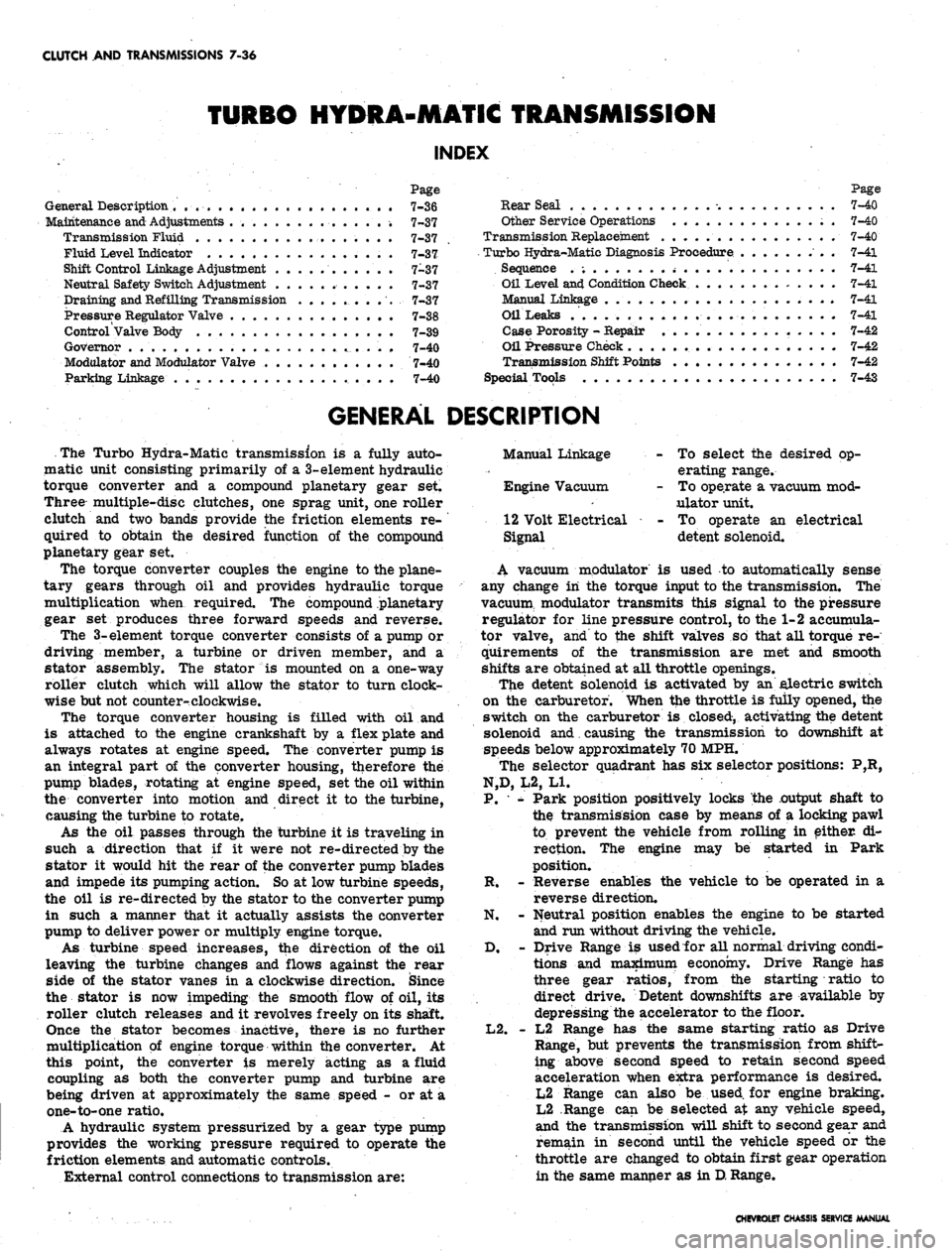
CLUTCH AND TRANSMISSIONS 7-36
TURBO HYDRA-MATIC TRANSMISSION
INDEX
Page
General Description . . , . 7-36
Maintenance and Adjustments . 7-37
Transmission Fluid 7-37
Fluid Level Indicator 7-37
Shift Control Linkage Adjustment ........... 7-37
Neutral Safety Switch Adjustment 7-37
Draining and Refilling Transmission . . . 7-37
Pressure Regulator Valve 7-38
Control Valve Body . 7-39
Governor ..'.... 7-40
Modulator and Modulator Valve 7-40
Parking Linkage . . 7-40
Page
Rear Seal -. 7-40
Other Service Operations . . 7-40
Transmission Replacement 7-40
Turbo Hydra-Matic Diagnosis Procedure. ......... 7-41
Sequence . ; ; 7-41
Oil Level and Condition Check 7-41
Manual Linkage 7-41
Oil Leaks .' 7-41
Case Porosity - Repair ................ 7-42
Oil Pressure Check 7-42
Transmission Shift Points 7-42
Special Tools 7-43
GENERAL DESCRIPTION
The Turbo Hydra-Matic transmission is a fully auto-
matic unit consisting primarily of a 3-element hydraulic
torque converter and a compound planetary gear set.
Three multiple-disc clutches, one sprag unit, one roller
clutch and two bands provide the friction elements re-
quired to obtain the desired function of the compound
planetary gear set.
The torque converter couples the engine to the plane-
tary gears through oil and provides hydraulic torque
multiplication when required. The compound planetary
gear set produces three forward speeds and reverse.
The
3-
element torque converter consists of a pump or
driving member, a turbine or driven member, and a
stator assembly. The stator is mounted on a one-way
roller clutch which will allow the stator to turn clock-
wise but not counter-clockwise.
The torque converter housing is filled with oil and
is attached to the engine crankshaft by a flex plate and
always rotates at engine speed. The converter pump is
an integral part of the converter housing, therefore the
pump blades, rotating at engine speed, set the oil within
the converter into motion and direct it to the turbine,
causing the turbine to rotate.
As the oil passes through the turbine it is traveling in
such a direction that if it were not re-directed by the
stator it would hit the rear of the converter pump blades
and impede its pumping action. So at low turbine speeds,
the oil is re-directed by the stator to the converter pump
in such a manner that it actually assists the converter
pump to deliver power or multiply engine torque.
As turbine speed increases, the direction of the oil
leaving the turbine changes and flows against the rear
side of the stator vanes in a clockwise direction. Since
the stator is now impeding the smooth flow of oil, its
roller clutch releases and it revolves freely on its shaft.
Once the stator becomes inactive, there is no further
multiplication of engine torque within the converter. At
this point, the converter is merely acting as a fluid
coupling as both the converter pump and turbine are
being driven at approximately the same speed - or at a
one-to-one ratio.
A hydraulic system pressurized by a gear type pump
provides the working pressure required to operate the
friction elements and automatic controls.
External control connections to transmission are:
Manual Linkage
Engine Vacuum
12 Volt Electrical
Signal
To select the desired op-
erating range.
To operate a vacuum mod-
ulator unit.
To operate an electrical
detent solenoid.
A vacuum modulator is used to automatically sense
any change in the torque input to the transmission. The
vacuum, modulator transmits this signal to the pressure
regulator for line pressure control, to the 1-2 accumula-
tor valve, and to the shift valves so that all torque re-
quirements of the transmission are met and smooth
shifts are obtained at all throttle openings.
The detent solenoid is activated by an alectric switch
on the carburetor. When the throttle is fully opened, the
switch on the carburetor is closed, activating the detent
solenoid and. causing the transmission to downshift at
speeds below approximately 70 MPH.
The selector quadrant has six selector positions: P,R,
N,D,
L2,L1.
P.
*
- Park position positively locks the output shaft to
the transmission case by means of a locking pawl
to prevent the vehicle from rolling in either di-
rection. The engine may be started in Park
position.
R. - Reverse enables the vehicle to be operated in a
reverse direction.
N.
- Neutral position enables the engine to be started
and run without driving the vehicle.
D,
- Drive Range is used for all normal driving condi-
tions and maximum economy. Drive Range has
three gear ratios, from the starting ratio to
direct drive. Detent downshifts are available by
depressing the accelerator to the floor.
L2.
- L2 Range has the same starting ratio as Drive
Range, but prevents the transmission from shift-
ing above second speed to retain second speed
acceleration when extra performance is desired.
L2 Range can also be used for engine braking.
L2 Range can be selected at any vehicle speed,
and the transmission will shift to second gear and
remain in second until the vehicle speed or the
throttle are changed to obtain first gear operation
in the same manner as in D Range.
CHIVROLET CHASSIS SERVICE MANUAL
Page 396 of 659
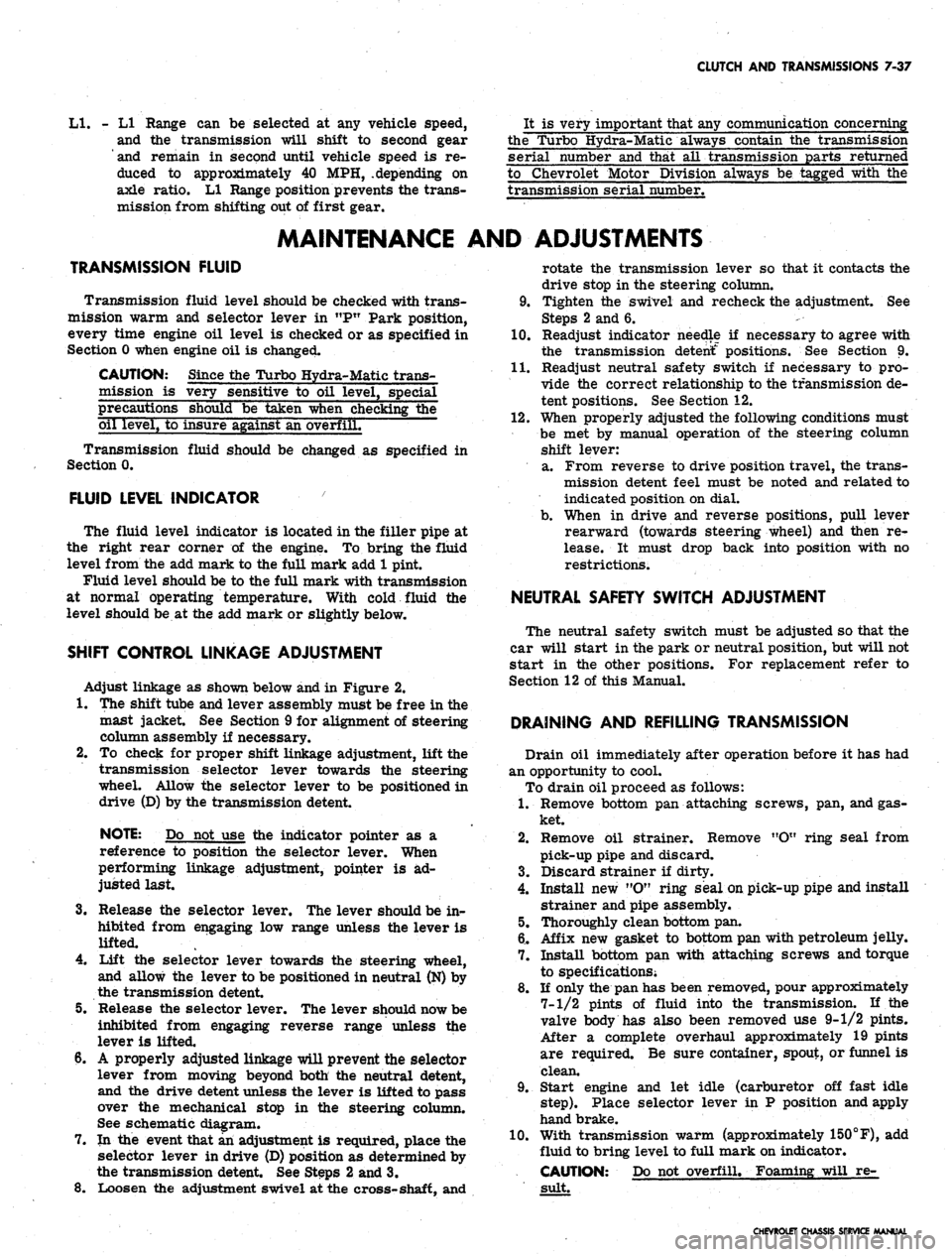
CLUTCH AND TRANSMISSIONS 7-37
LI.
- LI Range can be selected at any vehicle speed,
and the transmission will shift to second gear
and remain in second until vehicle speed is re-
duced to approximately 40 MPH, .depending on
axle ratio. LI Range position prevents the trans-
mission from shifting out of first gear.
It is very important that any communication concerning
the Turbo Hydra-Matic always contain the transmission
serial number and that all transmission parts returned
to Chevrolet Motor Division always be tagged with the
transmission serial number.
MAINTENANCE AND ADJUSTMENTS
TRANSMISSION FLUID
Transmission fluid level should be checked with trans-
mission warm and selector lever in "P" Park position,
every time engine oil level is checked or as specified in
Section 0 when engine oil is changed.
CAUTION: Since the Turbo Hydra-Matic trans-
mission is very sensitive to oil level, special
precautions should be taken when checking the
oil level, to insure against an overfifE
Transmission fluid should be changed as specified in
Section 0.
FLUID LEVEL INDICATOR
The fluid level indicator is located in the filler pipe at
the right rear corner of the engine. To bring the fluid
level from the add mark to the full mark add 1 pint.
Fluid level should be to the full mark with transmission
at normal operating temperature. With cold fluid the
level should be at the add mark or slightly below.
SHIFT CONTROL LINKAGE ADJUSTMENT
Adjust linkage as shown below and in Figure 2.
1.
The shift tube and lever assembly must be free in the
mast jacket See Section 9 for alignment of steering
column assembly if necessary.
2.
To check for proper shift linkage adjustment, lift the
transmission selector lever towards the steering
wheel. Allow the selector lever to be positioned in
drive (D) by the transmission detent.
NOTE: Do not use the indicator pointer as a
reference to position the selector lever. When
performing linkage adjustment, pointer is ad-
justed last.
3.
Release the selector lever. The lever should be in-
hibited from engaging low range unless the lever is
lifted.
4.
Lift the selector lever towards the steering wheel,
and allow the lever to be positioned in neutral (N) by
the transmission detent.
5.
Release the selector lever. The lever should now be
inhibited from engaging reverse range unless the
lever is lifted.
6. A properly adjusted linkage will prevent the selector
lever from moving beyond both the neutral detent,
and the drive detent unless the lever is lifted to pass
over the mechanical stop in the steering column.
See schematic diagram.
7.
In the event that an adjustment is required, place the
selector lever in drive (D) position as determined by
the transmission detent. See Steps 2 and 3.
8. Loosen the adjustment swivel at the cross-shaft, and
rotate the transmission lever so that it contacts the
drive stop in the steering column.
9. Tighten the swivel and recheck the adjustment. See
Steps 2 and 6. -
l(h Readjust indicator needle if necessary to agree with
the transmission detent" positions. See Section 9.
11.
Readjust neutral safety switch if necessary to pro-
vide the correct relationship to the transmission de-
tent positions. See Section 12.
12.
When properly adjusted the following conditions must
be met by manual operation of the steering column
shift lever:
a. From reverse to drive position travel, the trans-
mission detent feel must be noted and related to
indicated position on dial.
b.
When in drive and reverse positions, pull lever
rearward (towards steering wheel) and then re-
lease. It must drop back into position with no
restrictions.
NEUTRAL SAFETY SWITCH ADJUSTMENT
The neutral safety switch must be adjusted so that the
car will start in the park or neutral position, but will not
start in the other positions. For replacement refer to
Section 12 of this Manual.
DRAINING AND REFILLING TRANSMISSION
Drain oil immediately after operation before it has had
an opportunity to cool.
To drain oil proceed as follows:
1.
Remove bottom pan attaching screws, pan, and gas-
ket.
2.
Remove oil strainer. Remove "O" ring seal from
pick-up pipe and discard.
3.
Discard strainer if dirty.
4.
Install new "O" ring seal on pick-up pipe and install
strainer and pipe assembly.
5.
Thoroughly clean bottom pan.
6.. Affix new gasket to bottom pan with petroleum jelly.
7.
Install bottom pan with attaching screws and torque
to specifications;
8. If only the pan has been removed, pour approximately
7-1/2 pints of fluid into the transmission. If the
valve body has also been removed use 9-1/2 pints.
After a complete overhaul approximately 19 pints
are required. Be sure container, spout, or funnel is
clean.
9. Start engine and let idle (carburetor off fast idle
step).
Place selector lever in P position and apply
hand brake.
10.
With transmission warm (approximately 150°F), add
fluid to bring level to full mark on indicator.
CAUTION: Do not overfill. Foaming will re-
sult.
CHEVROLET CHASSIS SERVICE MANUAL